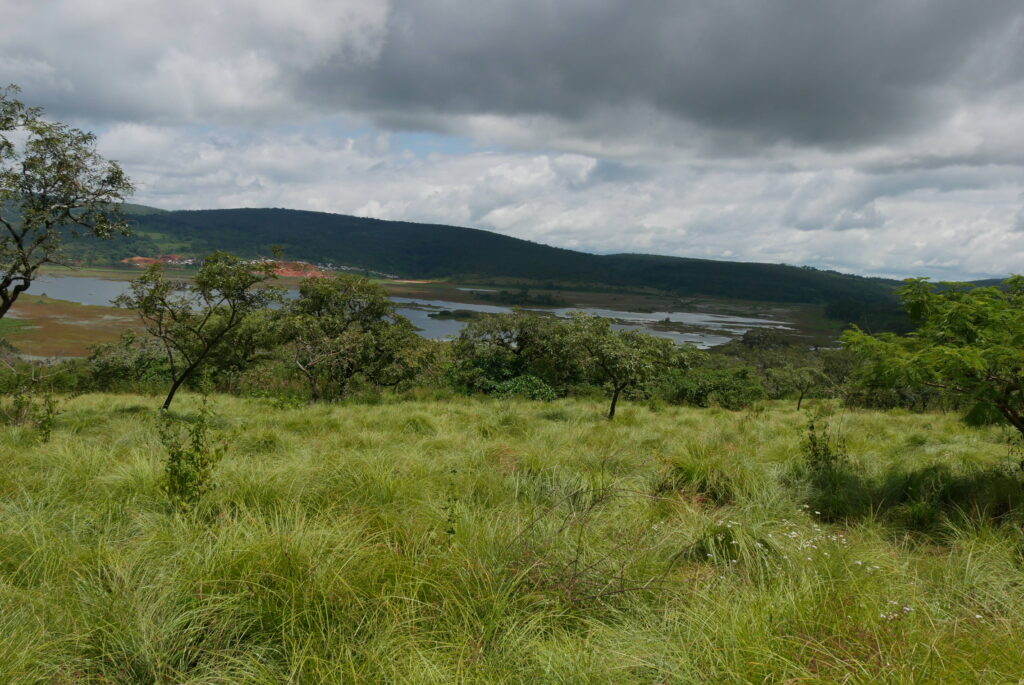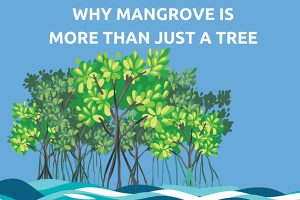Lake Sonfon is one of the rare mountainous lakes in West Africa, and one of the largest inland lakes in Sierra Leone. Located in the North of the country in Diang chiefdom, it is far away from the attention of the wider public. It is still not known to many that the lake surprises its visitors with its unique environment, plants, animals and birds. Being at Lake Sonfon will accord you the experience of special fragrant smell of the herbs and flowers growing therein, which is not easily found in many other places in the country. The lake is also home to embedded bird species like the Emerald Starling. It is a key biodiversity area, classified as an Important Bird Area (IBA) and one of the proposed protected areas of Sierra Leone.

Conserving Lake Sonfon for people and nature can work!
One of the biggest threats to Lake Sonfon, its biodiversity and the livelihood of the communities around the lake is water pollution and destruction of the ecosystem through mining. The Conservation Society of Sierra Leone (CSSL) has been working in and around Lake Sonfon for several years now, raising public awareness on the importance of conserving the lake as well as supporting communities with alternative livelihood options other than mining. The Conservation Society works closely with communities, local authorities, and the National Protected Area Authority (NPAA) in its quest to achieve all of these. All, therefore, celebrated a great success in 2021 when illicit mining was managed to be halted inside the proposed protected area and the buffer zone.
When foreign companies started mining with official licenses, several community mining sites were reopened - the fight to protect the lake starts again.
Earlier this year, the designated CSSL field staff at Lake Sonfon reported about resumption of mining activities by foreign companies inside the buffer zone of the proposed protected area. These activities are reported to be polluting the lake itself, and adversely affecting communities along the Pampana River, the only outgoing water source from the lake. As though this is not enough, Pampana River also hosts numerous mining activities which continue to compound more environmental problems relating to pollution of water sources in that part of the country. On 15th August 2023, the Environmental Protection Agency (EPA) together with the Sierra Leone Police and environmental actors arrested and destroyed several dredge mining equipment along the Pampana River to demonstrate EPA’s resolve to eliminate all sorts of illegal mining activities along the river and at the lake. Still, the full dimension of mining at Lake Sonfon is not yet clear until proper assessments and regular field visits are undertaken to document and consciously act to end illegal mining in the area.
Data collection is key: CSSL team documents the state of illegal mining around and inside Lake Sonfon
On 26th and 27th September, a team from CSSL went to document the current state of illegal mining in and around the lake, with very alarming findings. The former mining sites at Kikifarma and Sumuni, which were deserted in 2021 after sustained and coordinated actions from all actors, were discovered to have resurfaced. From the Western shore of Lake Sonfon, the huge mining sites, including workers and terrifying sounds of mining equipment at Kikifarma are visible and clear on the other side of the lake even without the use of binoculars. The mining in these two communities is especially dangerous for the turtle population which lives close by. The turtles are not only distracted by the mining itself but also the rather sustained water pollution ravaging their habitat.

Continuing further South along the lake, the CSSL team witnessed and documented several small-scale mining sites owned by community people. Even though they are small scale, they cause a huge amount of environmental destruction as the soil is ruined, waste is left behind, big pits dug out and left open, and there are no reclamation plans.
Close to Mankoni, several small sites were also documented with serious water pollution along the narrow part of Lake Sonfon. The color of the water has changed completely. There are several places where community members run machines without any precautions against oil pollution on the lake. This part of the lake is one of the places which hosts a lot of the West Africa Dwarf Crocodile. Next to the community mining sites, the foreign company, DOGON, which is said to be having a license for a mining concession area around the lake (but not directly at the lake) is operating a big mining site at Mankoni. When the CSSL team went to this site, they were vigorously interrogated by a government deployed security personnel, and witnessed huge impact of the mining activities on the environment. The company was busy pumping muddy water out of the mining pit into the lake. During these activities, they had to relocate several crocodiles from the rather extensive pit. The company as well as communities operate with machines of low environmental standards which spill oil to the soil and water bodies.
At the North-west end of the lake is Segbeia, one of the mining villages abandoned in 2021, has now grown into a big village close to the lake. There is small scale mining which also directly affects the lake – the means of potable water for nearby animals and humans.
Following the road to the West from Segbeia, huge mining sites and deep pits are operated by communities. Community members risk their health and lives with no safety precautions during mining. It is obviously a risky and very dangerous business to embark on, especially for poor local communities. With little or no sustainable alternative livelihood opportunities available, many are, however, compelled to work in the mines to eke out a living for themselves and their poor families. Interviews with community members proved that most are aware of the illegality of their actions, but have limited or no other options for their daily survival, with the big multi-national companies worsening the situation of community people.
“We have stopped mining in the protected area of Lake Sonfon. Through the engagements of CSSL, we understood that it is better for us not to mine close to the lake. But now the foreign companies have their licenses, and they chase us away from the mining sites where we were working. We don´t have any other option now than to enter into the protected area again.”
Foday Jawara, community member
Foday Jawara’s statement reflects the predicament of many other community members. When foreign companies send the community people away from their mining sites, they resort to reopening the sites close to the lake. This situation was attempted to be resolved by the Paramount Chief who designated a piece of land close to Bode Ose, a small community outside the buffer zone, for communities to undertake mining activities. This was however seen as not being enough to accommodate all community miners.
One challenge for the conservation of the lake is the lack of options for community members, but also the ignorance of foreign companies when it comes to the boundaries between their concession areas and the buffer zone of the protected area. At Darakuru, at the South end of the lake where it flows into the Pampana River, mining activities from Chen-Li company are reported. The license of this company covers an area close to the lake but still outside the buffer zone. This company seems to operate outside its licensed area, inside the protected area. There are more assessments needed to determine the full impact and the full expansion of illegal mining at Lake Sonfon. CSSL took the first step in the second week of September to document the current state of mining at Lake Sonfon´s western shoreline.
“With all that we have seen and learned through engagements of community members, CSSL volunteers, miners, and official reports – we are still left with the question: “Who is responsible to protect Lake Sonfon, and what will be done to conserve this unique environment, the cultural heritage of the Diang people and the livelihoods of communities around the lake?”
Abdul Kaprr Dumbuya, CSSL’s Communication Manager
Learn more about our engagement at Lake Sonfon to protect nature and save livelihoods: project page Lake Sonfon



